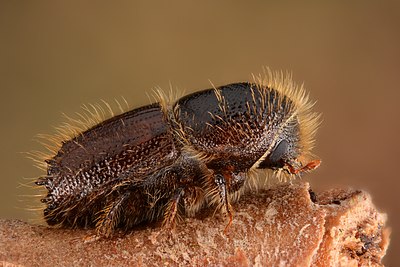Talk:European spruce bark beetle
| This article is rated C-class on Wikipedia's content assessment scale. It is of interest to the following WikiProjects: | |||||||||||||||||||||
| |||||||||||||||||||||
Sniffer dogs in use
[edit]I just read that someone in Finland has trained a sniffer dog to detect early stages of infestation.
They write that in Sweden there is already a service to hire such dogs.
Sorry I do not have links or references. This was from a news article in a Finish paper.
Idyllic press (talk) 21:36, 24 June 2020 (UTC)
Featured picture scheduled for POTD
[edit]Hello! This is to let editors know that File:Ips typographus_(female).jpg, a featured picture used in this article, has been selected as the English Wikipedia's picture of the day (POTD) for November 10, 2024. A preview of the POTD is displayed below and can be edited at Template:POTD/2024-11-10. For the greater benefit of readers, any potential improvements or maintenance that could benefit the quality of this article should be done before its scheduled appearance on the Main Page. If you have any concerns, please place a message at Wikipedia talk:Picture of the day. Thank you! — Amakuru (talk) 12:39, 1 November 2024 (UTC)

|
The European spruce bark beetle (Ips typographus), is a species of bark beetle in the true weevil family, Curculionidae. It is found in Europe, Asia Minor and east to China, Japan, North Korea and South Korea. Bark beetles are so named because they reproduce in the inner bark, living and dead phloem tissues, of trees. Their preferred trees in which to reside include spruces, firs, pines and larches. The species has the ability to spread quickly over large areas and some scientists hypothesize that long-distance movements originating from the Iberian Peninsula may have contributed to its invasion of northern Norway spruce forests. This female European spruce bark beetle was photographed in Naninne in the province of Namur, Belgium. Photograph credit: Ivar Leidus
Recently featured:
|

